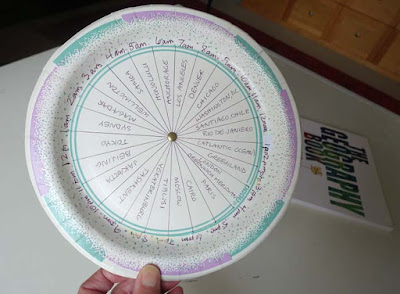Did you turn your clocks forward one hour last Sunday?
As we change our clocks to Daylight Savings Time, it is a good time to look at the time zones of the world. You can also make your own "World Clock" to see what time it is in other parts of the world in relation to the time where you live.
How to Make a World Clock
You will need:
- scissors
- 2 paper plates
- ruler
- pen
- brad
1. Cut the rim off one paper plate to make a flat circle.
2. Use the ruler and pen to divide the circle into 24 equal pie-shaped sections. Start by dividing the circle into quarters and divide these in half to make eighths. Then divide each of these into three smaller sections.
3. Write “London, Greenwich Mean Time” in one of the sections. Then, continuing clockwise find a city in each succeeding time zone and write the name in the following sections.
4. Place the circle with the city names on top of the other paper plate. Fasten them in the center with the brad.
5. On the rim of the plate, above the section that says “London,” write “12:00 Midnight.” Continue in a clockwise fashion writing 1:00 am, 2:00 am, 3:00 am, and so on, above each pie section, until you come back to “12:00 midnight.”
6. Look at the time on the rim above the time zone where you live. That is what the time is when it is 12:00 midnight in London. When you rotate the circle so that the time on the rim is your current time, the other pie sections will tell you what time it is in other cities in the world.
It takes 24 hours, or one day, for Earth to make one complete turn, or
revolution, in space. As each hour passes, Earth rotates approximately
15 degrees of longitude. At the 1884 International Meridian Conference,
it was agreed to divide the world into 24 time zones of 15 degrees each,
measured from the Prime Meridian in Greenwich, England. All other times
around the world are based on the time set in Greenwich, called
Greenwich Mean Time (or GMT.) The halfway point around the Earth,
centered on the 180th meridian, is called the International Date Line.
This is the point at which one day ends and a new day begins. The lines
separating the time zones do not always follow the meridians exactly.
Some of the divisions have been shifted to keep countries or communities
in the same time zone. In some parts of the world, such as India and
central Australia, the zones vary on the half hour so that noon occurs
when the Sun is at the highest point in the sky.
You can find this project and many other fun activities for exploring, mapping and enjoying your world in
THE GEOGRAPHY BOOK by Caroline Arnold.














